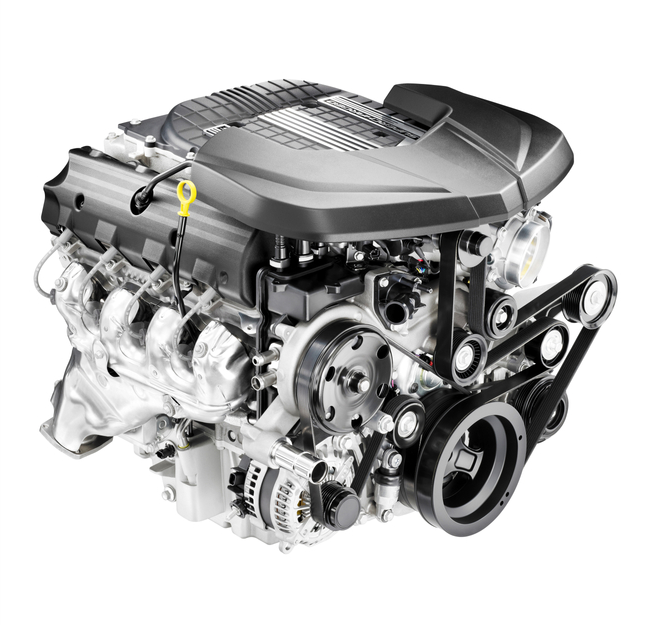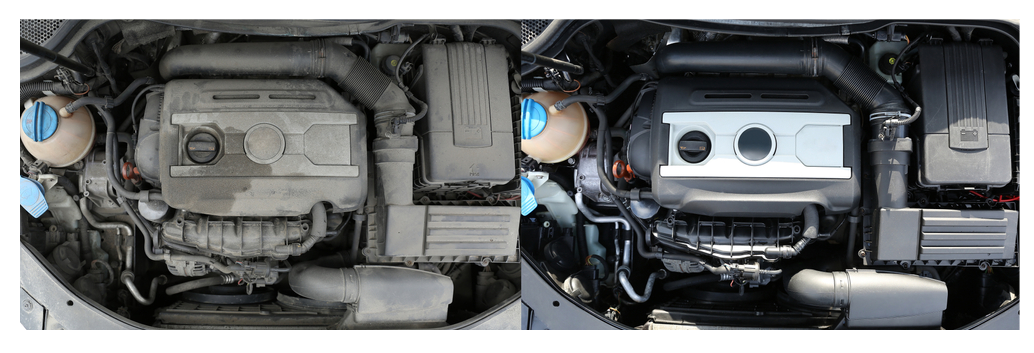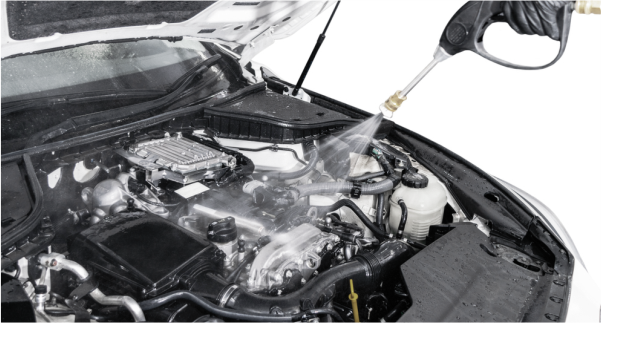 Made in Slovakia
Made in Slovakia ISO 9001
ISO 9001 Made in Slovakia
Made in Slovakia ISO 9001
ISO 9001The engine is undoubtedly the most important part of the car. Why should you worry about cleaning it and risk doing more harm than good? There are several good reasons why to clean the engine and fuel system of deposits that increase emissions and destroy the engine. Cleaning the engine compartment may seem complicated, but it is not rocket science. In this article you will learn how to safely ensure that your engine shines again.

Benefits of a clean engine
The engine is a part that becomes dirty relatively quickly. However, impurities do not only adversely affect its aesthetics. It is important to realise that the accumulation of dirt makes it difficult to identify any faults in the motor unit. If the engine is clean, identifying any leaks is much easier.
Combustion engines will never use 100% of the fuel that passes through the system. Fuel that does not burn stays in the engine. Inefficient engine combustion subsequently produces carbon. The engine begins to carbonize, which is demonstrated by a black lumpy surface on the walls of the engine. Engine decarbonization is done to remove all deposits, sediments, and coatings. Due to the injection of fuel directly into the cylinders, all cars continuously deposit carbon not only to the walls of intake manifolds, valve seats and stems, combustion chamber and spark plugs, but also to the EGR valve.

A clean engine has several great advantages:
- Increased engine power and compression.
- Extended service life.
- Reduced smoke, emissions, and fuel consumption.
- Fuel-air balance in the system.
- Easy detection of faults and facilitation of repairs
Water cleaning vs. dry-ice cleaning Cleaning the engine compartment may seem complicated, but it is not rocket science. If done correctly, you will not spoil anything. When cleaning with water, pay particular attention to the ignition system (especially in petrol engines, which simply does not like moisture). It must be thoroughly protected before cleaning. It is important to cover everything that should not get wet - air inlets, alternator, coils, electronic control unit, on-board diagnostics, etc. Never clean a hot engine. It is dangerous for you and your vehicle. Attempts to cool down an overheated engine with a cold-water jet can have serious consequences: metal parts might warp and no longer fit together afterwards. This causes frictions and in the worst case you risk causing a crack the engine compartment. For cleaning, it is advisable to use a degreaser that is suitable for engine as it will not damage the rubber and vinyl parts. After washing the engine, it is important to dry the engine compartment. Cleaning the engine washes out the oil and coolant. The polluted water should not reach the sewage system.
Cleaning the engine compartment may seem complicated, but it is not rocket science. If done correctly, you will not spoil anything. When cleaning with water, pay particular attention to the ignition system (especially in petrol engines, which simply does not like moisture). It must be thoroughly protected before cleaning. It is important to cover everything that should not get wet - air inlets, alternator, coils, electronic control unit, on-board diagnostics, etc. Never clean a hot engine. It is dangerous for you and your vehicle. Attempts to cool down an overheated engine with a cold-water jet can have serious consequences: metal parts might warp and no longer fit together afterwards. This causes frictions and in the worst case you risk causing a crack the engine compartment. For cleaning, it is advisable to use a degreaser that is suitable for engine as it will not damage the rubber and vinyl parts. After washing the engine, it is important to dry the engine compartment. Cleaning the engine washes out the oil and coolant. The polluted water should not reach the sewage system.
"Most service providers still work with a high-pressure cleaner, but today modern technology is already available, which is very safe and so efficient that the engine will look like new"...
Something for perfectionists: dry ice cleaning
Cleaning – dry ice blasting is a modern, ecological, non-abrasive method of industrial cleaning. The cleaning process uses three basic factors: kinetic energy, thermal shock, and sublimation. Only dirt and no other secondary waste remains from the cleaning process, as is the case, for example, with pressure cleaning. This makes the dry ice cleaning method efficient, gentle on the materials being cleaned and at the same time environmentally friendly. With dry ice you can ecologically and gently remove carbon deposits, dirt, or surface rust without the need to dismantle the cleaned equipment, thus saving time and money. There are no legal restrictions on the use of dry ice. The method is 100% ecological and non-abrasive.
Dry ice is a frozen carbon dioxide compressed into small pellets. Dry ice vaporizes immediately on contact with treated surfaces and degreases all loose dirt particles. The result is such a clean engine that you would almost think you own a new car. In addition, dry ice cleaning is very safe. Damage to the electrical system can be almost completely ruled out.

The innovative ecological method of dry ice blasting has almost no limitations in terms of cleaned materials or surfaces. It is non-abrasive, non-toxic, and non-conductive, without the use of chemicals and production of secondary waste. It is used in almost all areas of industry, where it also speeds up the cleaning process because it allows cleaning during operation and without the need to cool and dismantle the equipment. Constant emphasis on ecology, cost reduction and quality improvement in production processes predetermine our technology for the future use.
- - - - - - - -
How does such dry ice cleaning work? Watch in a short video: